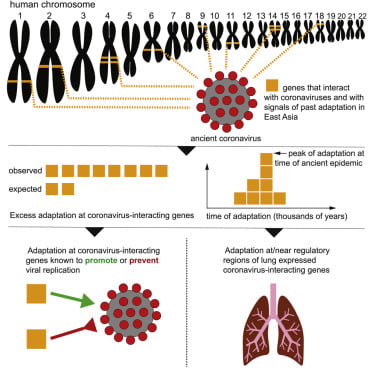So far what did we know about the history of human coronavirus? The earliest reports of coronavirus infection date back to the 1960s in the United Kingdom and the United States. Fast forward to 2003, 2012 and 2019, and the scientists confirmed about three human coronaviruses over the years which had the potential to spread epidemic called SARS-CoV (SARS), MERS-CoV (MERS) and SARS-CoV-2 (COVID-19) respectively. But a new study has suggested that coronavirus may have hit humans over 20,000 years ago in East Asia also and possibly the devastation was so strong that its imprints are still available on the DNA of people in countries like China, Japan and Vietnam.
How do we know about an over 20,000-year-old epidemic?
The answer lies in human genomes actually which contain tens of thousands of years of evolutionary information helping the scientists identify the viruses that have impacted our ancestors – which also point to viruses with future pandemic potential.
Study of genomes points to ancient coronavirus pandemic
Thus for the new study published in the journal Current Biology, the genomes of over 2,500 people from 26 populations across the world were analysed and the stamp of an over 20,000-year-old coronavirus epidemic was found in 42 different human genes from East Asia.
Now, what was the stamp or signature that revealed the ancient coronavirus pandemic?
We know that virus needs to interact with specific proteins of the host cell, called viral interacting proteins (VIPs), for an invasion into the human bodies. When the scientists – David Enard from the University of Arizona and Yassine Souilmi from the Australian National University among others – examined the genomes of over 2500 people for a set of viral interacting proteins that interact with coronaviruses and applied the ancestral recombination graph approaches to the study, they found some VIPs which may have come under selection around 900 generations (over 20,000 years) ago.
But the traces were present in 5 of the 26 populations only and all of them from East Asia. Therefore, the analyses suggested that the ancestors of East Asians were also exposed to coronaviruses over 20,000 years ago.

Revelations on antiviral mutations may help fighting pandemic
“It should make us worry,” said David Enard, an evolutionary biologist at the University of Arizona who led the study, according to the New York Times report. He added, “What is going on right now might be going on for generations and generations.”
Essentially, so far as the scope of this study is concerned, the ancient coronavirus was limited to the East Asia region only because the scientists didn’t find its traces in the genomes of people from the other regions.
The study revealed that all these 42 genomes underwent the same number of antiviral mutations between 20,000 and 25,000 years ago. The research is expected to help in the search for medicines to fight the current COVID pandemic, while the evolutionary genetic analyses may provide a new tool for fighting future outbreaks.









India braces for heatwave: Top tips to stay safe in sweltering conditions
Stress managemnt: 10 tips to manage anxiety issues
Flight cancelled or delayed? Guidelines you must know